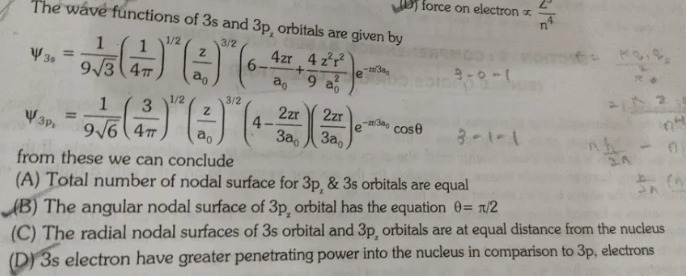Question
Question: The wave functions of 3s and 3p₂ orbitals are given by Ψ₃ₛ = $\frac{1}{9\sqrt{3}}(\frac{1}{4\pi})^{...
The wave functions of 3s and 3p₂ orbitals are given by
Ψ₃ₛ = 931(4π1)1/2(a0z)3/2(6−a04zr+9a024z2r2)e3a0−zr
Ψ₃p₂ = 961(4π3)1/2(a0z)3/2(4−3a02zr)(3a02zr)e3a0−zrcosθ
from these we can conclude

Total number of nodal surface for 3p₂ & 3s orbitals are equal
The angular nodal surface of 3p₂ orbital has the equation θ= π/2
The radial nodal surfaces of 3s orbital and 3p₂ orbitals are at equal distance from the nucleus
3s electron have greater penetrating power into the nucleus in comparison to 3p₂ electrons
A, B, D
Solution
The given wave functions for the 3s and 3pz orbitals are:
Ψ₃ₛ = 931(4π1)1/2(a0z)3/2(6−a04zr+9a024z2r2)e3a0−zr
Ψ₃p₂ = 961(4π3)1/2(a0z)3/2(4−3a02zr)(3a02zr)e3a0−zrcosθ
Let's analyze each conclusion:
(A) Total number of nodal surfaces for 3pz & 3s orbitals are equal.
The total number of nodes for an orbital with principal quantum number n is given by n−1. For both 3s and 3pz orbitals, n=3.
Total nodes for 3s = 3−1=2.
Total nodes for 3pz = 3−1=2.
Alternatively, the total number of nodes is the sum of radial nodes and angular nodes.
The number of angular nodes is equal to the azimuthal quantum number l.
For s orbitals, l=0. Angular nodes for 3s = 0.
For p orbitals, l=1. Angular nodes for 3pz = 1.
The number of radial nodes is given by n−l−1.
Radial nodes for 3s = 3−0−1=2.
Radial nodes for 3pz = 3−1−1=1.
Total nodes for 3s = Radial nodes + Angular nodes = 2+0=2.
Total nodes for 3pz = Radial nodes + Angular nodes = 1+1=2.
The total number of nodal surfaces is indeed equal for 3s and 3pz orbitals. This conclusion is correct.
(B) The angular nodal surface of 3pz orbital has the equation θ= π/2.
Nodal surfaces are regions where the wave function Ψ is zero. The wave function Ψ₃p₂ has an angular part proportional to cosθ. The angular node occurs when the angular part is zero, i.e., cosθ=0. This happens when θ=2π (or θ=23π, etc.). The surface described by θ=2π in spherical coordinates is the xy-plane. This conclusion is correct.
(C) The radial nodal surfaces of 3s orbital and 3pz orbitals are at equal distance from the nucleus.
Radial nodal surfaces occur when the radial part of the wave function is zero (excluding r=0 and r=∞).
For Ψ₃ₛ, the radial part is proportional to (6−a04zr+9a024z2r2). Setting this to zero gives the radial nodes:
6−a04zr+9a024z2r2=0.
Let x=a0zr. The equation becomes 6−4x+94x2=0. Multiplying by 9/4, we get 454−9x+x2=0, or x2−9x+227=0.
Using the quadratic formula, x=29±(−9)2−4(1)(27/2)=29±81−54=29±27=29±33.
Since x=a0zr, the radial nodes for 3s are at r=za0(29−33) and r=za0(29+33). These are two distinct distances.
For Ψ₃p₂, the radial part is proportional to (4−3a02zr)(3a02zr). Setting this to zero gives the radial nodes:
(4−3a02zr)(3a02zr)=0.
This gives two possibilities:
-
3a02zr=0, which implies r=0. This is the nucleus, not a radial node.
-
4−3a02zr=0, which implies 3a02zr=4, so r=2z4⋅3a0=z6a0.
There is one radial node for 3pz at r=z6a0.
Comparing the radial node distances for 3s (za029−33 and za029+33) and 3pz (z6a0), we can see they are different. For example, 29−33≈29−5.196=1.902 and 29+33≈29+5.196=7.098, while 6. None of the 3s radial node distances are equal to the 3pz radial node distance. This conclusion is incorrect.
(D) 3s electron have greater penetrating power into the nucleus in comparison to 3pz electrons.
Penetrating power refers to the probability of finding an electron close to the nucleus. For a given principal quantum number n, orbitals with lower azimuthal quantum number l have greater penetrating power. This is because the radial probability distribution function P(r)=4πr2∣Ψ(r,θ,ϕ)∣2 is non-zero at r=0 only for s orbitals (l=0). For l>0 (like p orbitals where l=1), the wave function is zero at r=0, making the probability density at the nucleus zero. The 3s orbital (l=0) has a non-zero probability density at the nucleus (∣Ψ3s(0)∣2=0), while the 3pz orbital (l=1) has zero probability density at the nucleus (∣Ψ3pz(0)∣2=0). This indicates that 3s electrons are more likely to be found closer to the nucleus than 3pz electrons, meaning 3s electrons have greater penetrating power. This conclusion is correct.
Based on the analysis, conclusions (A), (B), and (D) are correct.
